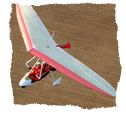| To our west,
the bay of Yell looked an interesting option, with a field sloping
up-hill. It peaked on top to the name of what I later discovered was
called the Hill of Lusseter with a 30 degree slope. As we approached over the cliffs, the picture was quite dramatic,
with inky blue sea below us. I flared as we crossed over the fence
and within moments we were down.
I had never seen a more surprised expression than I had when we
taxied to the top of the field. A 79 year old elderly man looked
stunned, and had what looked like a pipe dangling from the side
of his mouth.
“Um… Hi, you look a bit surprised. I wondered if we
could buy some fuel from you?”
Very soon we were joined by two other locals who were keen to see
what had landed.
“We saw you coming down, we though you had crashed into the
ground!” Gavin, one of them said.
I called Scatsca who may have been wondering where we might be.
Whilst we hunted around for jerry cans, the elderly man suddenly
appeared in his Vauxhall Corsa with a black plastic petrol carrier. £16 of fuel later, we were ready to go again. The wind was
rolling down the hill and were about to discover that fuel and weight
calculations are especially important during a very short field
takeoff. We had less than 160 metres with the upslope, and no second
chances if the engine stopped.
At the top of the hill was a disused car and a spiked, rusting tractor
rake, sitting in deep tractor tracks. We found some steel poles
and filled in the rut as best we could, giving maximum coverage
in case we overshot and needed the extra distance. I walked the
length of my planned takeoff run and noticed the ground undulated
on the sloping ground. It was going to be a very tight and the room
for error very small. I had to make full use of as much field as
possible. We taxied slowly to the bottom of the hill and stopped
just short of where the grass was starting to become clumped together
in mounds, 5 metres from the fence. We turned for takeoff into wind.
Now at full power and in the long grass, we were creeping only
slowly over the damp ground.
2/3 of the way up the hill, we rolled over a small lip and the trike
bounced into the air, mometarily knocking my foot off the throttle
as it started sinking again. It was not at flying speed yet. The
car and rut were approaching fast and too close for comfort.
I saw Gavin and his friend looked on as I pushed the throttle to
the floor and the rake rushed past our left side as we started to
climb.
I looked behind and watched the bay grow smaller below us as in
the picture on the right. I said a big thankyou to whoever had been
smiling down on us.
Returning to Tingwall airfield was a welcome sight and once more
the winds were light. The Islander aircraft followed us in, and
I got talking to the pilot, Noel. Very soon, it was his turn to
try out the purest form of aviation!
As we got strapped in, Noel bombarded me with lots of interesting
questions. The moment we lifted off, I heard a loud “This
is awesome!” in my ears. I took it from that that he was enjoying
himself.
We discussed what a solid and docile plane the Islander was, and
how a 30 knot crosswind poses no problem at all for it.
Noel ran us back to the Bed and Breakfast that evening, but not
before we collected the fuel cans that Martin at the airfield had
loaned us to get fuel. There was no doubt they had been exposed
to the Shetland elements. On the outside they were nearly orange
with rust.
As I filled up at the garage in preperation for the longest leg
of the journey, a trail trickled along the forecourt. The fuel had
started leaking out of the bottom of the jerry can and I sheepishly
positioned it over the drain. I bought two 5 litre containers and
transferred it into them.
TINGWALL - UNST – 12:30 – 13:30
UNST – YELL FIELD - 13:40 – 14:00
YELL FIELD – TINGWALL - 15:00 – 15:20
NOEL(TINGWALL) – (TINGWALL) – 17:00 – 17:45
Total Flying: 2:55 mins
|





